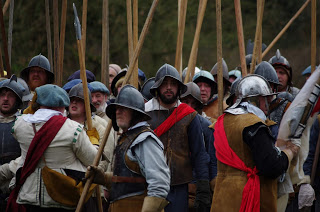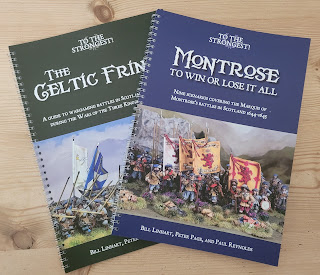Painting Guide - Horses
Caveat: if you want a guide to painting horses that employs 16 shades of the same colour to highlight and lowlight horse flesh look away now. This is a quick and easy average painter's guide to painting horses averagely.
So I always used to paint horses as quickly as possible, dark brown, with dark brown manes and tails, and dark brown tack. My token gesture to 'not dark brown' was the occasional white flash or sock.
Here is my current horse formula. Well it works for me, and my horses look, well, horse like.
Colours: I avoid greys and blacks unless absolutely necessary (commanders being known for only riding horses of a specific colour, or certain Napoleonic cavalry units). So my horses are almost exclusively chestnut, bay or dun. In the seventeenth century there wear superstitions surrounding horse colours: black horses were the devil's horse (which is handy because black horses are really really difficult to paint well), greys were seen as unlucky (again, buggers to paint convincingly).
My starting point is Coat d'Arms horse tone paints. They look awful when block painted - chestnut is too red, bay looks orange. Bear with it! Next up I paint in manes and tails (black for bays chestnuts, and duns, roan and brown horses get bone manes and tails). Next I dry brush their legs black if they have black tails (technical name for this is 'points'). This really tones the block colours down, and the horses start to look a bit more horse like, but still looks too bright. Roan horses are again Cd'A horse tome roan, with Cd'A wood brown tail and mane.
Tack is next, Cd'A wood brown, blankets and saddles as appropriate. Then pick out buckles and bits with Foundry metal.
A light wash with Citadel Nuln Oil, then flashes and socks in white. Socks are not as common as you would think in real life, but they make horses look more horsey, so they are fairly common in my armies. Socks come in patterns: you'll find one by itself; a pair will be either front or back or on one side, never in opposite corners; rarer still you'll find all four legs with socks. Lots of superstition about the number of socks, but they do finish a horse off nicely so I'm ignoring them.
Of course a subscriber to 'Horse and Hound' would be mortified, but they look sufficiently horse-like for me not to care.
Finally, here's my recipes for all those bloody awkward colours of horses to paint:
Buoyed by giddiness, the catalyst for this I know not what: I have decided to take on the nemesis of all inadequate painters - grey horses. Fortunately I'm painting 15mm sized horses so can get away with a mediocrity that could not be entertained by 28mm painters.
Looking at pictures of greys online they seem to fall into two camps (equine geneticists look away now, you'll only be terribly disappointed) - grey blacks, and grey whites. The grey blacks have much darker manes and tails and legs, the grey whites have almost white tails and manes. Here's my recipe for grey blacks.
Starting point Coat d'Arms horse tone grey.
Then it is time to add the tricky bits.
Using an Army Painter stippling brush with almost a dry brush quantity of paint on the very tip of the bristles, I added RailMatch weathered black on the hind and fore quarters, utilising an almost stabbing motion. A note on using the stippling brush - before use stab the bristles (with force) onto a hard surface. Try and make the bristles start to splay out a little bit. Do this a few times. Softening up the brush like this gives a better effect.
Once dry, next a stipple of Foundry granite 31C.
Finally a very light stipple of Cd'A white.
Last but not least tail and mane were added using RailMatch weathered black; lower legs were blackened too.
I added blue saddle blankets which had the effect of making the horses look blue, particularly around the back legs. Whilst my brain was telling me that it was just down to the blue blankets, my eyes were tricking me into wanting to strip the horses and start again.


Not really something that will look brilliant in close up pictures - remember these are 15mm horses. This method gives a pleasing effect at tabletop level, it ain't going to win you a prize in a miniature painting competition.
 |
Starting point Coat d'Arms horse tone grey.
Then it is time to add the tricky bits.
Using an Army Painter stippling brush with almost a dry brush quantity of paint on the very tip of the bristles, I added RailMatch weathered black on the hind and fore quarters, utilising an almost stabbing motion. A note on using the stippling brush - before use stab the bristles (with force) onto a hard surface. Try and make the bristles start to splay out a little bit. Do this a few times. Softening up the brush like this gives a better effect.
Once dry, next a stipple of Foundry granite 31C.
Finally a very light stipple of Cd'A white.
Last but not least tail and mane were added using RailMatch weathered black; lower legs were blackened too.
I added blue saddle blankets which had the effect of making the horses look blue, particularly around the back legs. Whilst my brain was telling me that it was just down to the blue blankets, my eyes were tricking me into wanting to strip the horses and start again.


Once they had their riders attached and had a Nuln Oil wash they stopped looking blue.
Here's one 'in situ'...
Black horses are a necessary evil, once every so often you will have to try and paint a black horse. I paint mine RailMatch weathered black, with neat Cd'A black main/tail and points. A very light dry brush with a mid to dark grey (I've now settled on Foundry slate grey 32B). One of the few times I forego a Nuln Oil wash.
As for white horses I have finally settled upon Foundry Austrian white light 67C, with Foundry Arctic grey 33A mane and tail; a little flesh dry brushed around around the horse's muzzle seems to work wonders. Finished off with a Nuln Oil wash.
If you enjoyed reading this, or any of the other posts, please consider supporting the blog.
Thanks.
















An interesting read. I've made good use of the Cd'A horse colours to date. I was neither aware of the superstitions around horses nor the relationship in number to the socks (my horses have 1-4 socks randomly based on how I'm feeling and most also have a blaze on the nose). It just goes to show you can learn something new most days!
ReplyDeleteSaddle blankets have struck me as a way of possibly getting some 'regimentation' into BCW cavalry units. It's certainly helped me identity which stands should go together in the past.
I wonder if horses is something you might want to consider researching for a future article. I've always thought most rules unfairly indicate Scottish horseflesh was inferior, something I've put down to Cromwell's Marston Moor account of those 'few Scots horse in our rear.' However, the Scottish horse appear to have done quite well in their initiation campaigning in Northern England (e.g. the action at Corbridge) and you don't see people downgrading thier Gordon Horse to any degree for the 'elite' Scots Royalist army somegamers fixate upon.
Thanks. Glad to hear that you have found it useful.
DeleteI do get quite a few compliments about how I paint horses, so thought I'd share my quick and easy way. They look suitably horse like to my untrained eye.
As for a horse article... not the biggest fan of horses I must confess, so maybe!